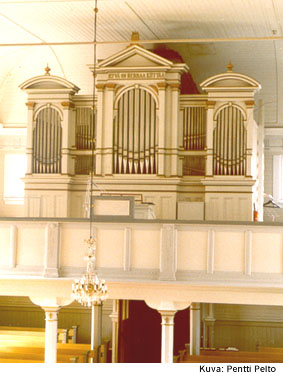|
HISTORICAL ORGANS IN FINLAND 
Pori Ahlainen- Thulé, Bror Axel 1909
- 16 stops, 2 manuals and pedal
- pneumatic action and pneumatic stop action
Ahlainen Church is a wood church jointly designed by Salomon Köykkä-Köhlström and the Office of Public Works. It was completed in 1796. In the repairs carried out by Josef Stenbäck in 1908, the nave church was converted into a cruciform church.
At the time when the Ahlainen organ was built (1909), the pneumatic action had become a mature technology, although it continued to evolve in some of its details over several years. This organ has been spared all changes, apart from the addition of a blower and the sawing off of the foot levers, apparently at the same time. In terms of sound, this instrument is one of the finest from this period.
Appearance
The organ is located in the west loft of the church, with plenty of room to spare. The middle flat of the five-part façade is topped with a pediment with a harp over it. The intermediate flats are two-tiered, and the border between the tiers continues over the pillars from side to side of the façade. The façade is rich in form, but the side walls are simple screens. Between the organ and the back wall of the church there is a narrow passageway originally intended for the organ blower.
The structure of the organ follows the in-line principle. Behind the façade is the Manual I division, then the maintenance access space and then the Manual II swell box. The Pedal chest and its pipes are at the back. This shows the dynamic design of the organ: the loud manual is in front and the quiet manual is behind it. The quiet manual can be further quietened by using the swell box.
Technical features
The chests are pneumatic stop channel chests with small bellows-operated relays at their edges. This detail is practically the only one separating these chests from the type that was introduced around 1916 and remained in use until the 1960s.
Under the chests is a large double rise reservoir to whose bottom plate two feeder bellows are affixed. The latter are operated by foot levers, whose alternate motion is ensured by a large backfall. A pleated channel leads from the top frame of the bellows to the wind trunk between the halves of the chests, from which the stop pallets allow the air into the stop channels. Each division has a concussion bellows to compensate for fluctuations in air pressure caused by repeated chords.
The rather small console is in front of the organ; the organist sits facing the church and can see the church proper over the top of the console. The keyboards have celluloid and ebony coverings as per the practice of the day. The stops are activated using oblique stop tabs; the knobs of the automatic pedal changer can be found above the Pedal stop tabs. This changer engages a quieter registration for the Pedal as soon as the organist moves his hands to Manual II. The action is pneumatic; this type of action is sometimes known as tubular pneumatic.
Musical properties
The pipes are typical for the builder. The metal flute stops are of an alloy containing about a third of tin, whereas the proportion of tin is about double that in the Principal and violin stops. The open pipes are tuned using tuning slots. This method, developed by Andreas Reuter, fine-tunes the sound of the pipe following Romantic sensibilities. The largest wood pipes are of varnished pine, while the smaller ones are of varnished birch.
Typically, the disposition has a strong Manual I with loud stops. These form the foundation of the organ’s sound, complemented by the quieter and moodier colours of Manual II. The Trumpet is the only reed stop, even in the Pedal there is a strong Violon instead of a Posaune. It is quite appropriate to talk of ‘loud’ and ‘quiet’ stops, since Bror Axel Thulé himself used these terms in his writings from the 1880s onwards.
Disposition
Manual I C-f3 | Manual II C-f3 | Pedal C-d1 |
Borduna 16' | Gedacht piano 16' | Violon 16' |
Principal 8' | Geigen principal 8' | Subbas 16' |
Gamba 8' | Flöjt amabile 8' | - Gedacht 16' |
Konsertflöjt 8' | Aeoline 8' | Gedacht 8' |
Octava 4' | Voix celeste 8' | |
Mixtur 3 kör | | |
Trompet 8' | | |
| | |
| | |
| | |
| | |
| | |
| | |
|
|
|
Couplings: II-I, I-Ped, II-Ped, I 4’, II-I 16’ | | |
Fixed groupings: mezzoforte, forte, tutti | | |
Automatic pedal changer, Manual II in swell box | | |
| | |
| | |
| | |
| | |
| | |
| | |
| | |
| | |
| | |
| | |
|